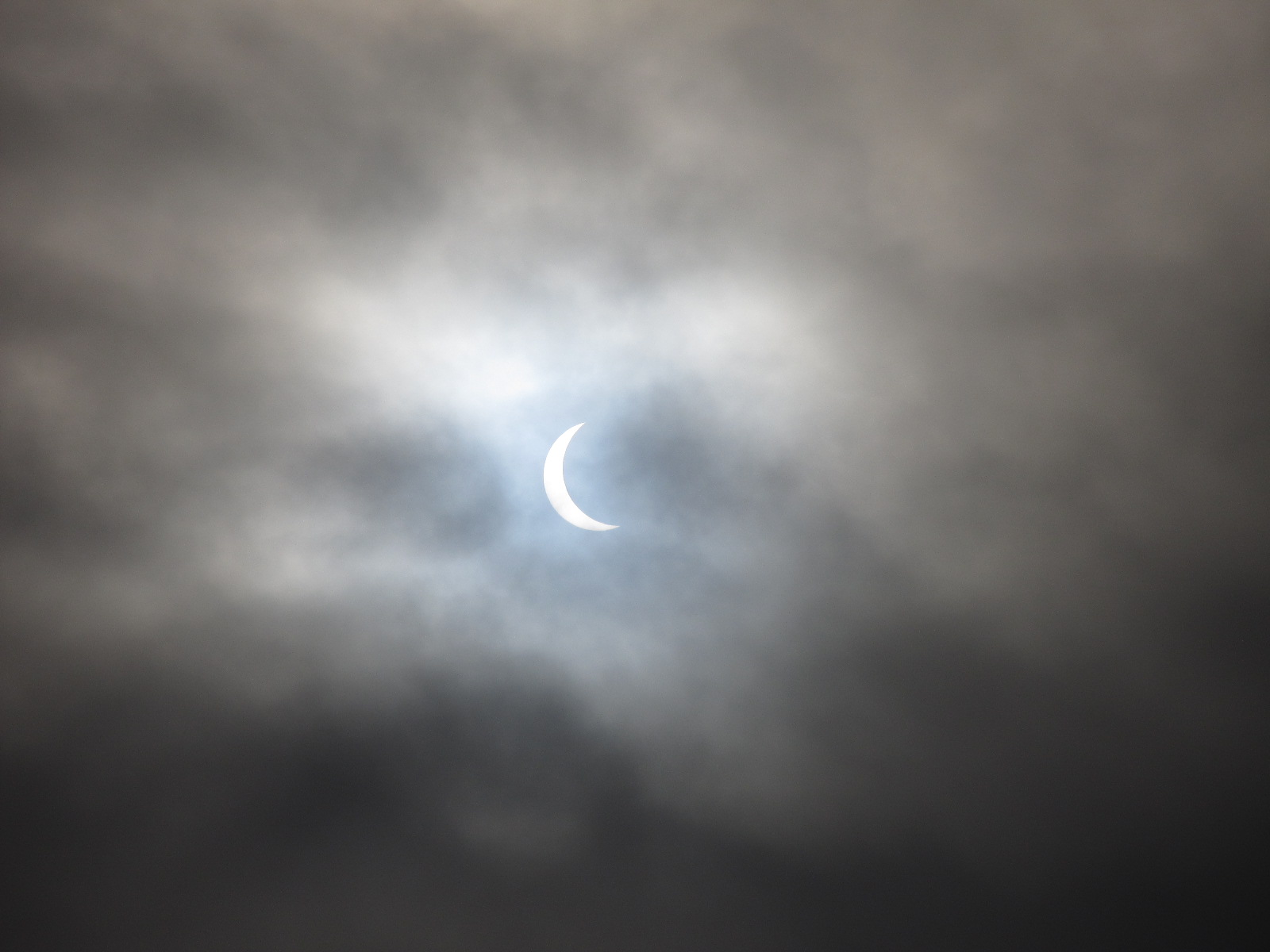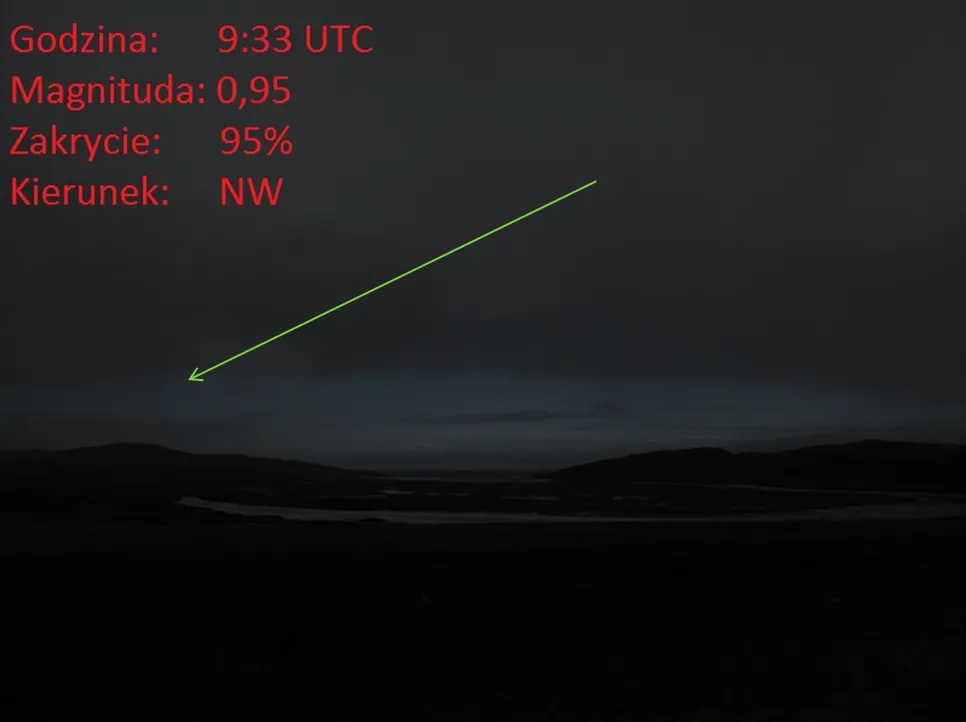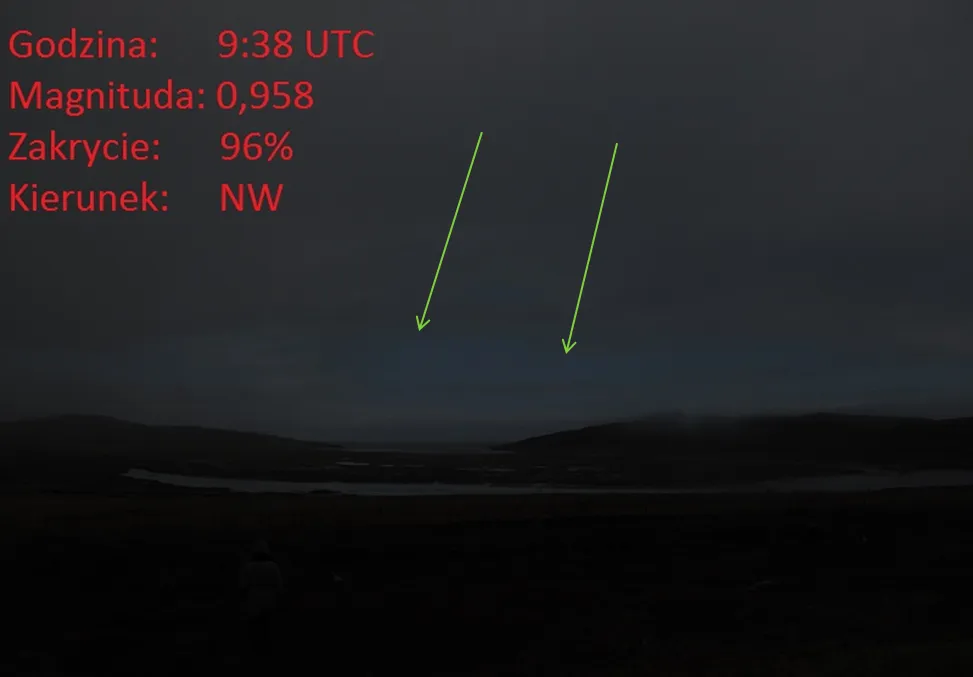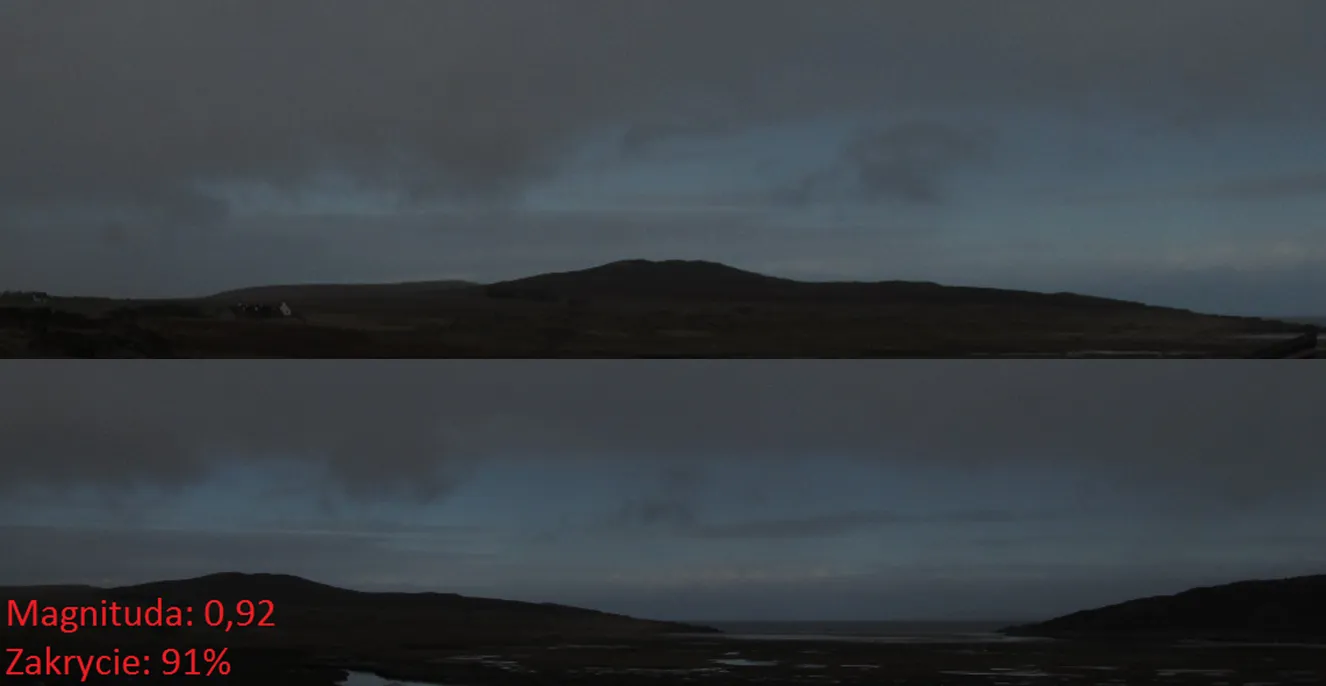On 20th March 2015, we could witness one of the most spectacular phenomena in the Solar System, the total solar eclipse. The track of totality passed across the North Atlantic and next headed into the Arctic Ocean. This eclipse used to be a logistical nightmare to observe because the only populated places from which the totality could be seen were the Faroe Islands and Svalbard.
The breadth path of totality passed tantalizingly close to southeast Iceland, where people experienced around 99,5% partial eclipse and were able to see the Moon’s shadow on the high-altitude clouds beyond. The path of totality almost touched the Rockall islet the westernmost point of the British Isles and the South-east corner of Iceland (Djupivogur and Breiddalsvik), where the distance was 37km only.

Many tourist agencies and private organizations decided to chase this eclipse due to its location between highly developed areas (mainly European Union). Unfortunately, the track of the totality was not passed favourably. The area of the North Atlantic, which is fed from the Golfstrom current is characterized by a few degrees of warmer water. Thanks to this region is a real hotbed for low-pressure systems and a nice route for huge windstorms headed for north and central Europe. It incurs a big cloud coverage across the region and high precipitation.
The best places to see the almost total solar eclipse were: northwest Norway (Lofoten), south Iceland and north Scotland (the Shetland Islands, Orkney Islands, Outer Hebrides, and Highlands Region). There are locations, where Moon covered more than 96% solar disk (Pic.1). Taking into account the Sun altitude during the eclipse the best places to go were Lofoten, Faroe Islands, and northwest Scotland (Pic.2).
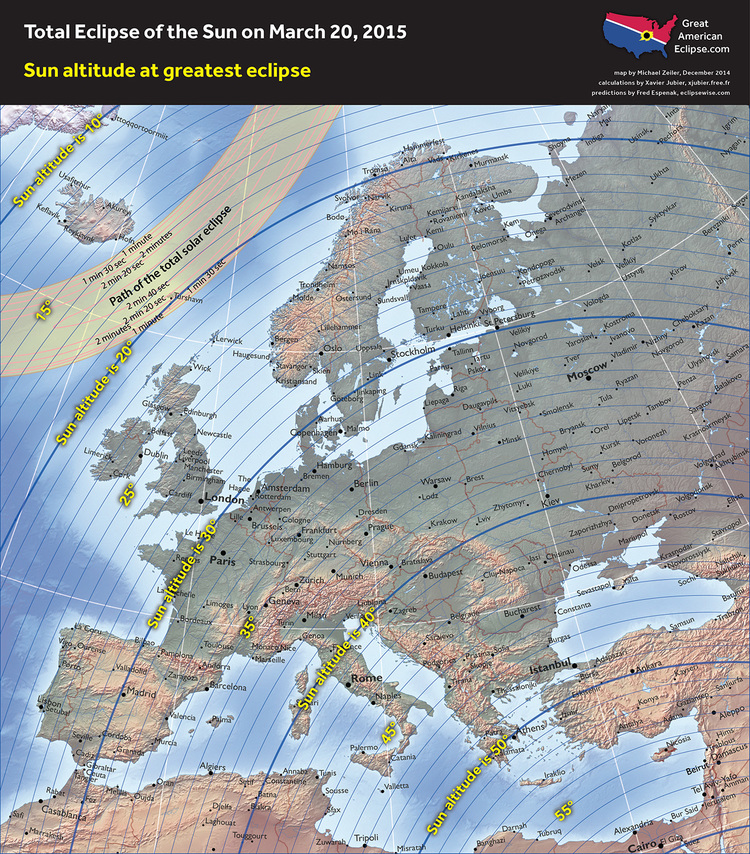
During this obscuration, the solar corona becomes possible to see, however it is barely visible to eagle-eyed observators. This situation is possible because the solar corona is nearly the same brightness as a Full Moon (0.23 full Moonlight, something around -11mag). Taking into account the brightness of Venus (-4,5mag), which is visible in the sky during the day the solar corona would be visible also, though it must be outside the Moon’s limb and this is possibly just around the annular, hybrid, or total solar eclipse. On the other hand, during this level of obscuration, the sunlight density is around 24x smaller than usual. In higher obscuration, this effect is stronger, up to totality, when the coronal streamers are clearly visible. These locations were not a place guaranteeing good weather during this occurrence. Everybody, who decided to take part in this natural phenomenon both in the path of totality and the locations listed above would expect truly different kinds of weather. It was a crapshoot.
I was looking forward to the 2015 solar eclipse since winter in early 2011 when I took a small observation of the deep partial solar eclipse in Krakow. Basically, I dreamed about the Spitsbergen expedition, seeking people and astronomy clubs, who could go there. Many people realized, that the organization of this scouting trip will be very expensive and quite pointless due to weather conditions. Finally, I couldn’t find a group, to which I would go. Meanwhile, my situation has changed due to emigration. I started to live in Great Britain in February 2015.
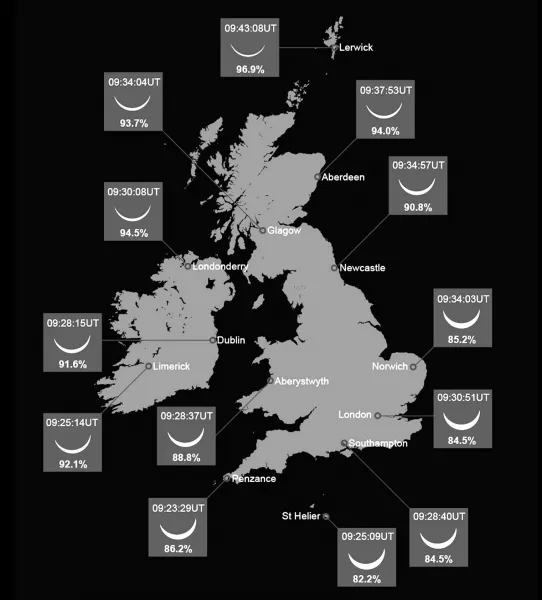
Despite this difficult challenge I never gave up and I decided to organize this “expedition” on my own. Because of the weather conditions, I choose the closest and the cheapest way to see this eclipse. I wish I could go to Iceland, the Faroe Islands, or Spitsbergen, but always when I decide to go somewhere I would very much like to see some remarkable spots. In this case, it could not be really possible due to the weather. Hence I decided to go as close as possible to my location – in north Scotland. On top of that, the accommodation in the path of totality and the deepest eclipse had been booked much time in advance, and only some of the most expensive were left.
I was considering visiting the Outer Hebrides and watching the almost total solar eclipse from there, but finally, I decided to stay on the Scottish mainland. Despite a little bit lower eclipse magnitude I could always go somewhere else, catch the better weather and visit some interesting places.
The weather situation around March 20, 2015, wasn’t good in northwest Europe. It was a few cyclones, which went one by one through the eastern Atlantic Ocean and the Norwegian Sea towards the Scandinavian Peninsula. The chances to see this beautiful phenomenon were very low because mostly the sky was covered by at least 2 layers of clouds. When I was checking the weather satellite imagery, the sunny spells were visible only somewhere above the sea. Just a few days before the eclipse the weather forecast in the United Kingdom wasn’t so good also. They predicted a lot of sun for the southern part of Britain, Ireland, and southern Scotland. Regrettably, the area of the deepest eclipse was going to be the rainiest in the whole UK. This forecast didn’t deter me. I came to the conclusion, that it will be good to have from this observation anything. I planned the light density change observation anyway, so in the worst case, good weather was not required. However, it was really good to have as best weather possible to see the whole eclipse effect.
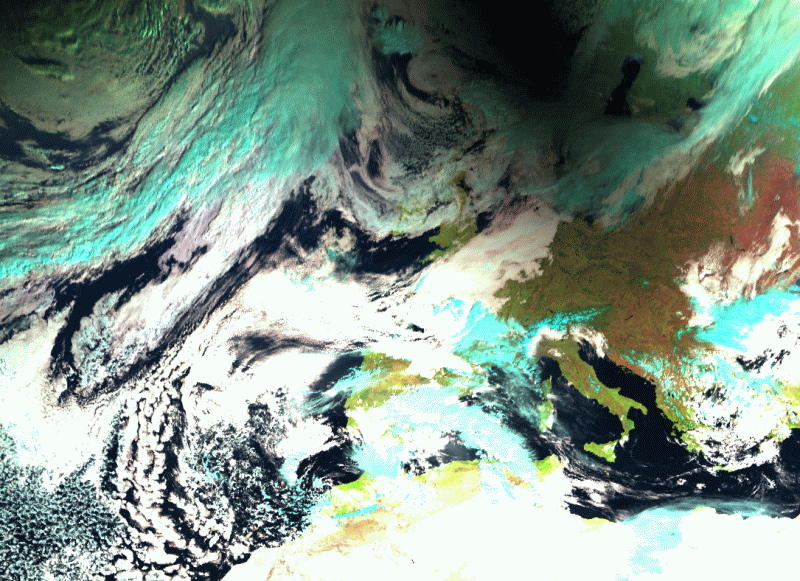
We set from Cambridge on Wednesday, March,18 in the late afternoon and after a full one-day journey (via London, Edinburgh, and Inverness) we came to Ullapool on Thursday, March 19, at 19:00.
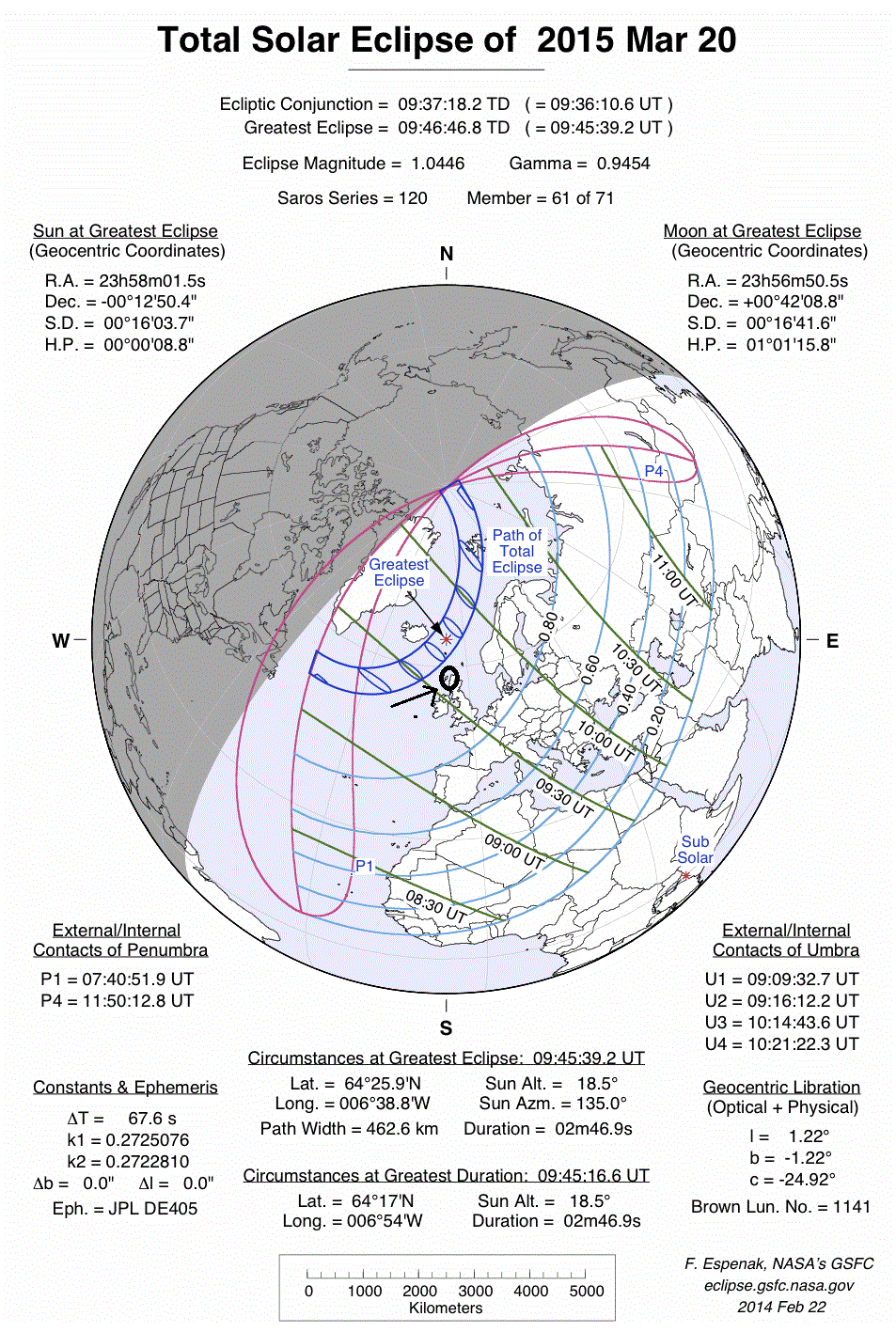
Thursday night was a nightmare for me. I was tossing and turning all night long and watching the most actual infrared weather images. It wasn’t optimistic, because rainy fronts were coming towards Scotland one by one.
Friday’s dawn was really bad. I could hear passing downpours through the window. My girlfriend said: “If you had stayed in Cambridge you would make the observation, but here you will have nothing”. Despite the fatal weather conditions I decided to leave our hotel quite early, around 7:00, and go ahead heading north-west.
Ullapool is a small ferry town in the western part of the Highlands region. The climate of this place is amazingly warm. There is even 1 palm tree, but I couldn’t see it due to bad weather and lack of time. Anyway, the townscape is really nice (Pic.7). In this area, rain takes hold all year round and it’s hard to enjoy really good weather.

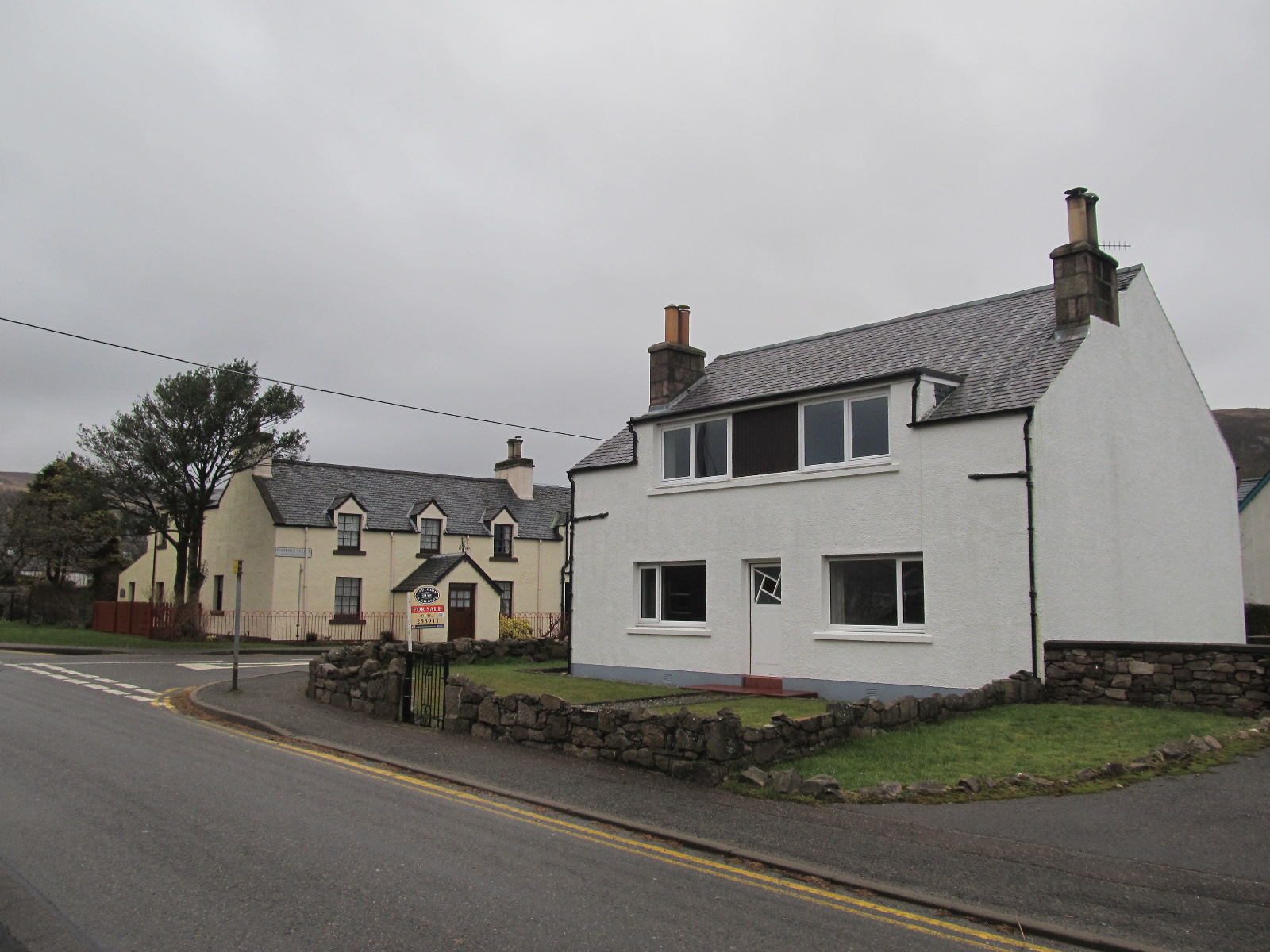
When we left Ullapool, the weather started to improve. The thick dark clouds gave way to sunny spells and patches of blue sky. After around 20 minutes away in Drumrunie we turned left into Achnahaird. This way was really narrow and difficult to beat due to many bends and sheep coming constantly across the road (Pic.8).

I chose this route because I saw wide patches of clear sky above the west horizon. I thought, that the rainy front is definitely gone and the weather will be improving. I was going to image the northwest horizon and catch the Moon’s shadow passing through the ocean. First I had to cross the Cul Mor community to see the lower horizon with the sea. When we passed those tors then, we stopped on the heather-clad area with a far-reaching view of the sea and remote another part of the British mainland beyond (Pic.9,10).
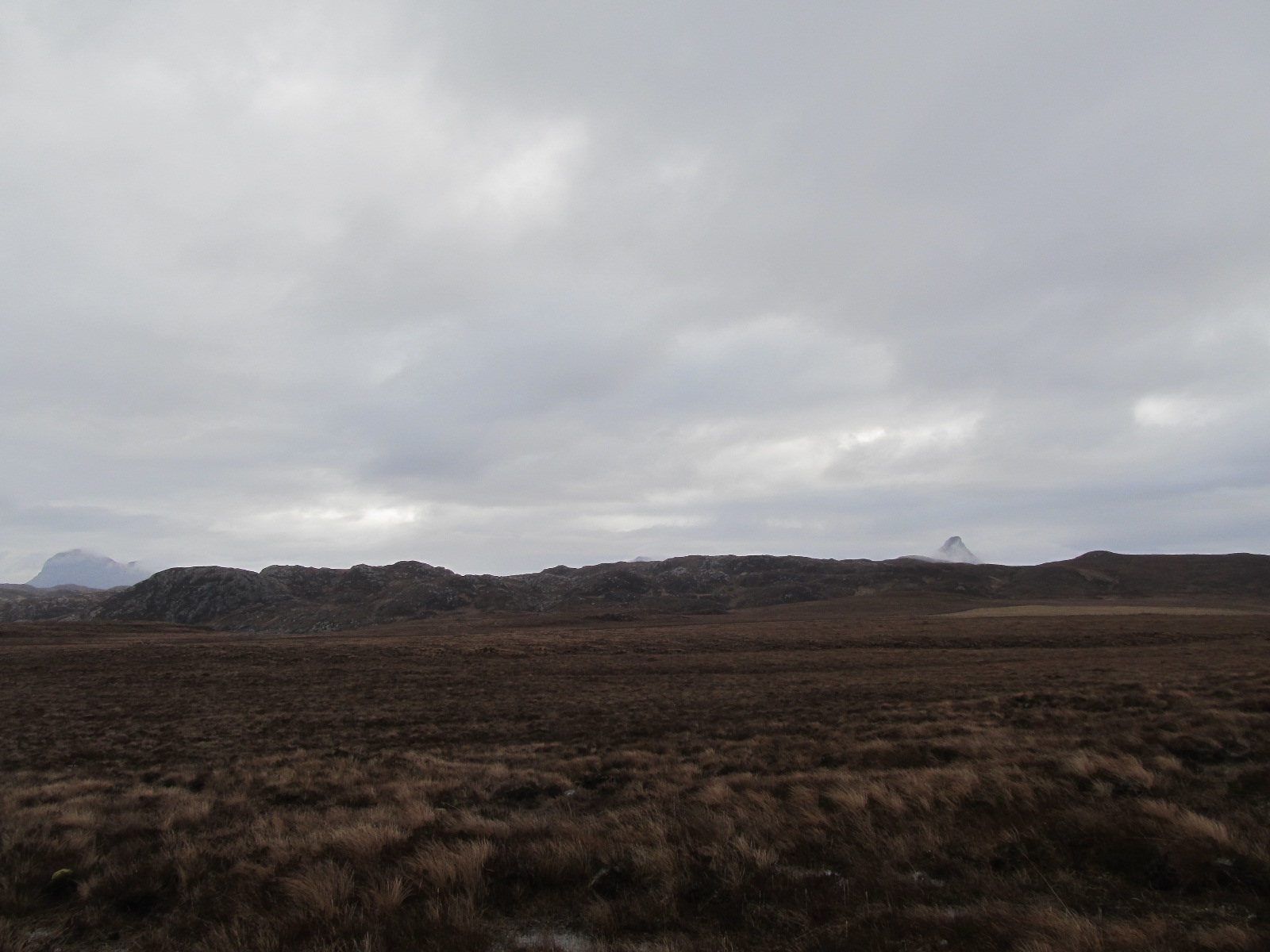
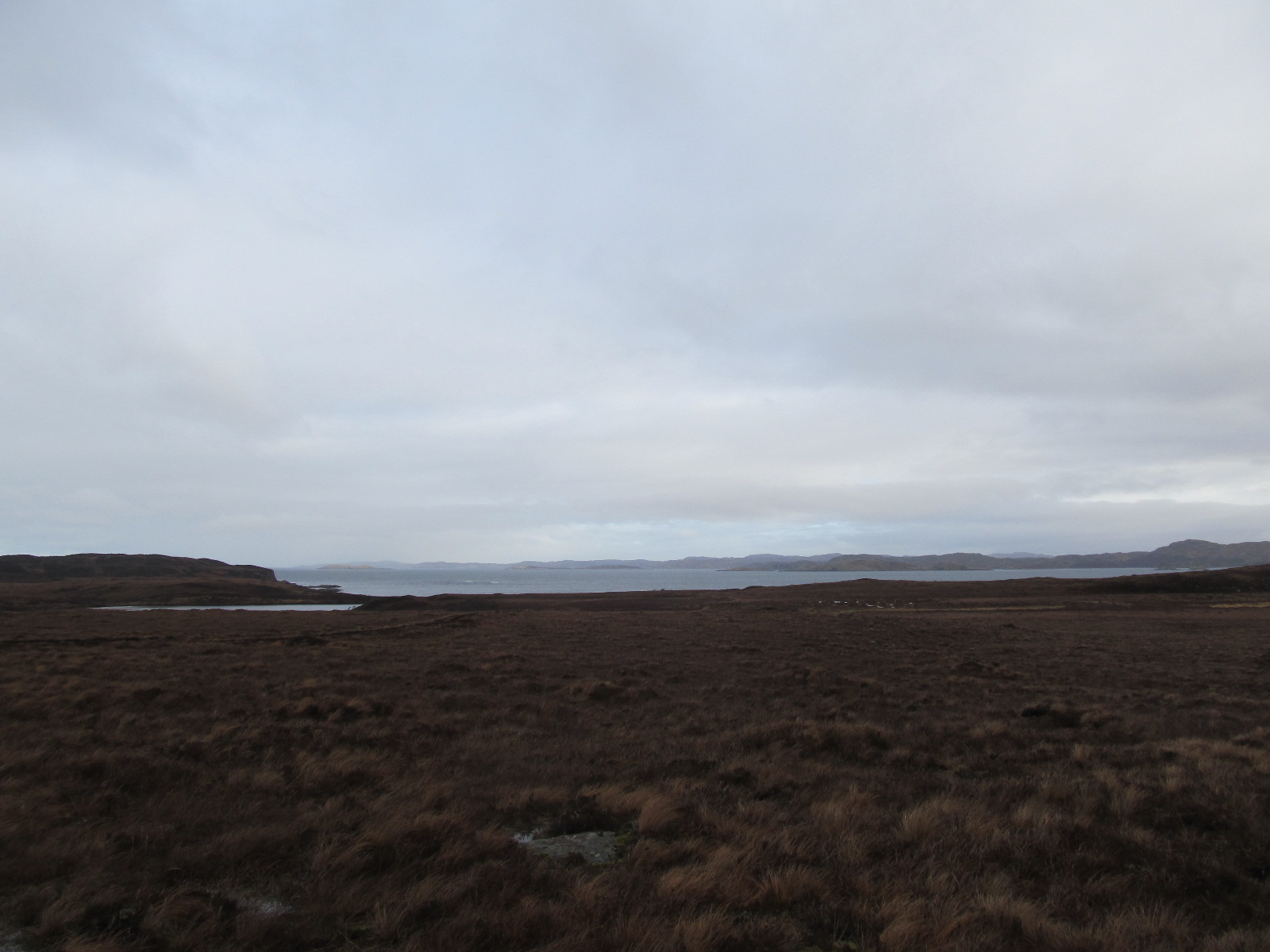
I was really happy because the weather was improving. I could even see the first shaft of sunlight just after the thick low-level clouds. I started to observe the eclipse from there. Unfortunately, this place wasn’t good, because the sunny spells coming from the seaside were disappearing above Caledonian’s Mountains hillsides behind our back above the southeast horizon. Besides, we witnessed one short rain shower. After 15 minutes I decided to change the observation place and go forward around 2km, where the weather seemed to be better.
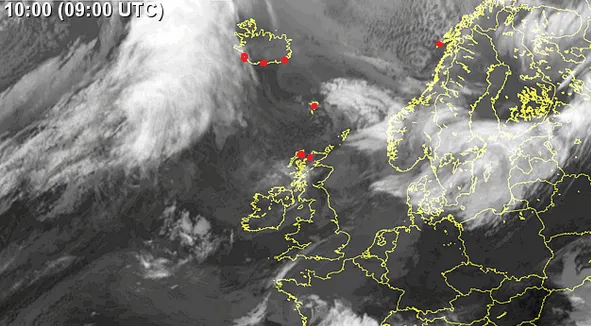
There I continued the observation. Everything was fine, the eclipsed sun was shining and I could carry out my duty. Unfortunately 15 minutes before the greatest eclipse the weather was worrying again. I saw a huge cloud coming directly at the sun. Afterward started raining. I saw a crescent Sun 6 minutes before the maximum. It got me very disappointed, though in the vicinity, above the northwest horizon a huge section of clear sky was passing by. I saw a remote part of the British mainland, which was sunlit. I could see a Moon’s shadow also. Next, the huge rain swept across our site and the crescent Sun was gone until 10:10 when was completely bright. In general, I did a mistake, because if I had known that it is going to be like that I would have gone to Lochinver and tried to set in the near villages situated on another part of the Scottish mainland. In this case, I could see clearly the greatest eclipse, but possibly without the northwestern sky, because I saw other clouds just behind the clear section of the sky (Pic.12).

From my side, I could only see the diminishing sunlight over there, which gave prominence to the local lighthouse (Stoer Lighthouse), much brighter during the greatest phase. It was exactly 295km to the path of totality from my place (Pic. 13,14).

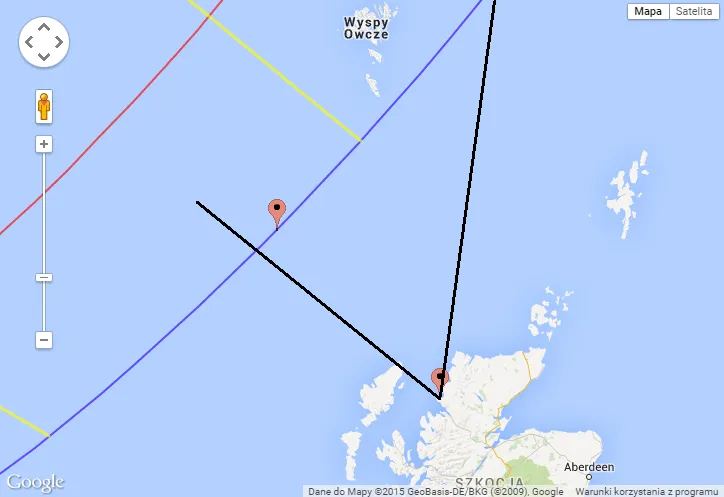
The observation
My basic goal during this almost total solar eclipse was to watch the decreasing density of light. I imaged this phenomenon in four directions:
– Southeast (Sequence A), towards the eclipsed Sun (Pic.15),
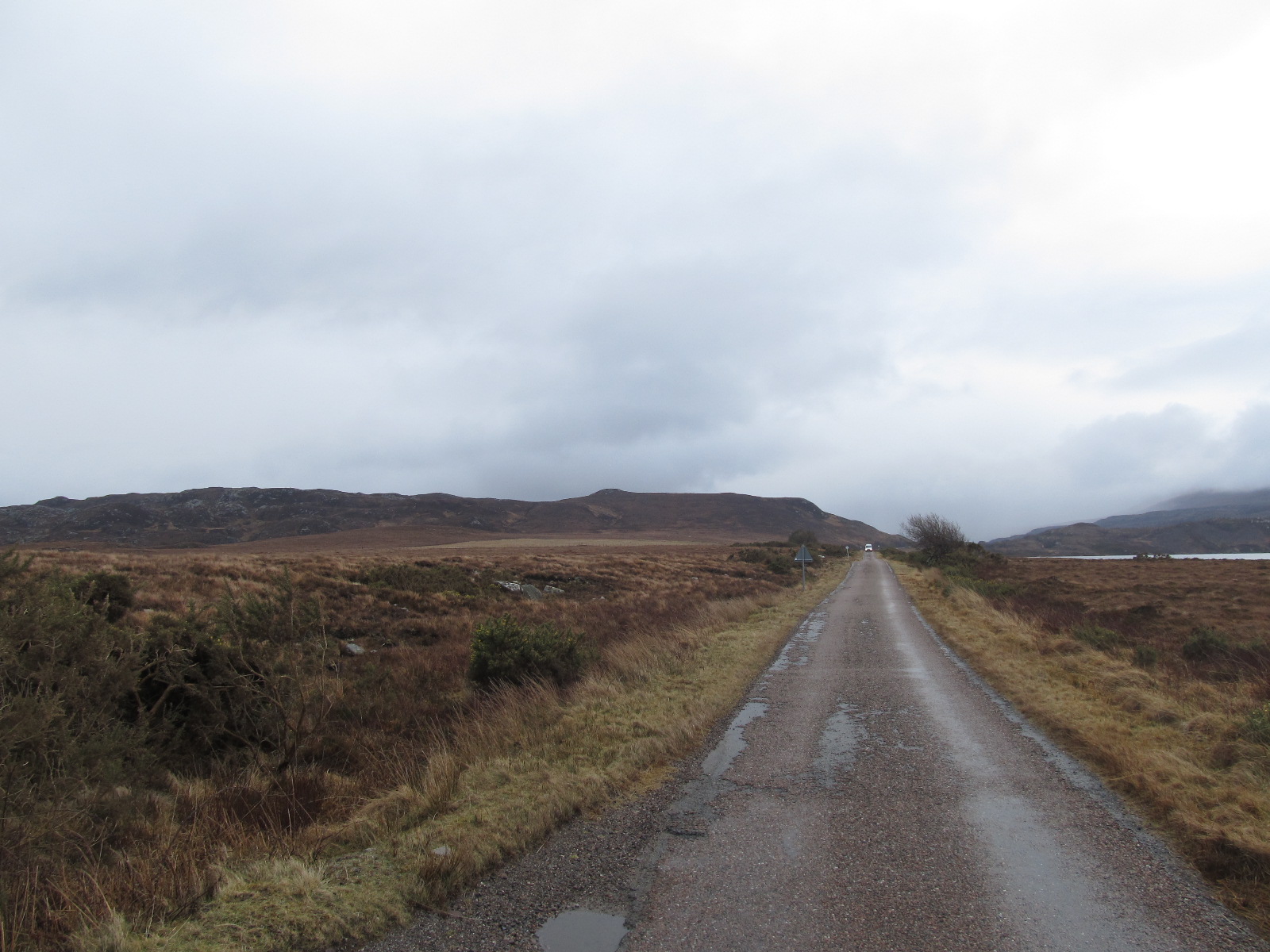
– west (Sequence B) in order to capture the darkening sky before the maximum eclipse (Pic.16,17),
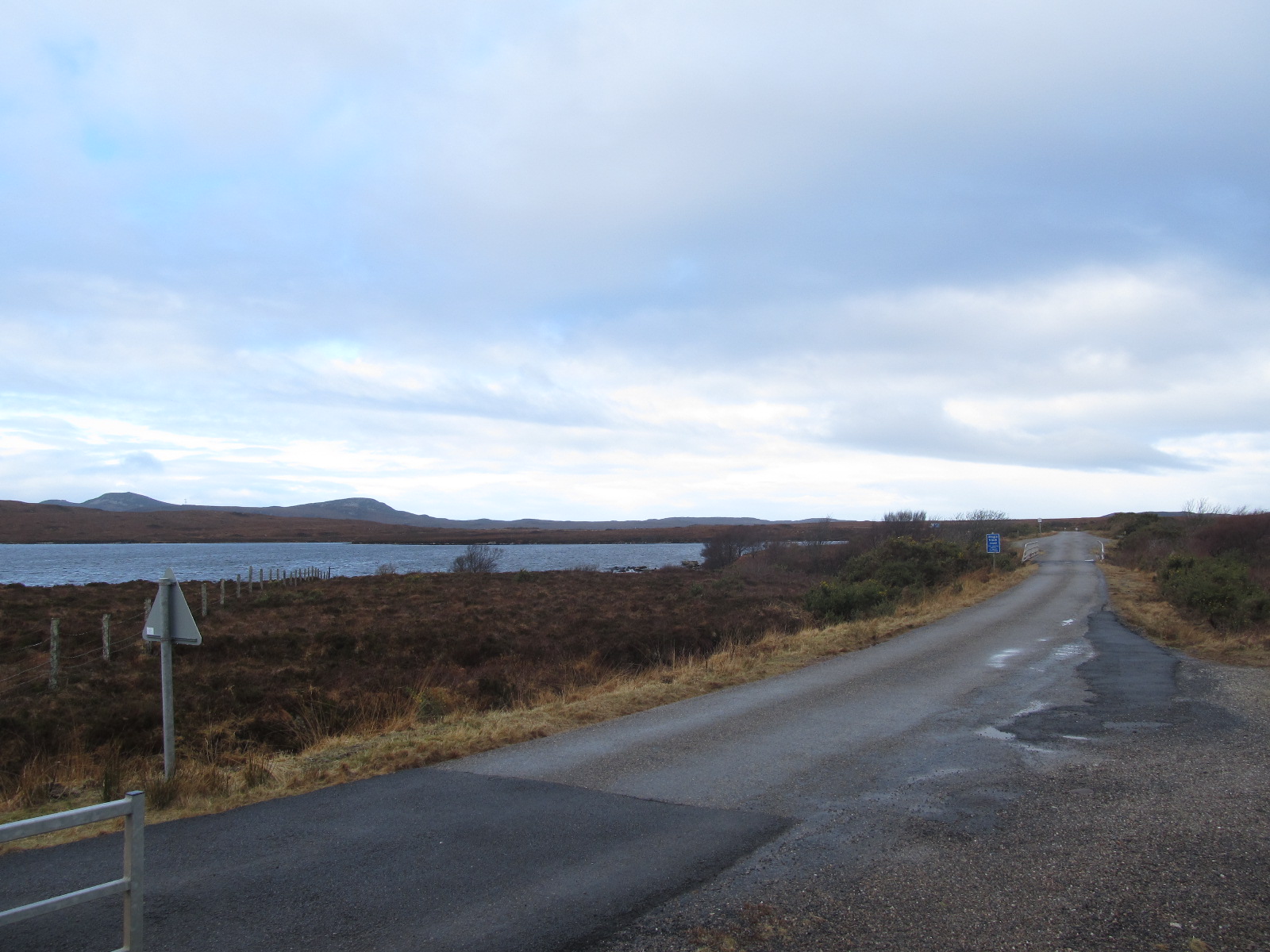
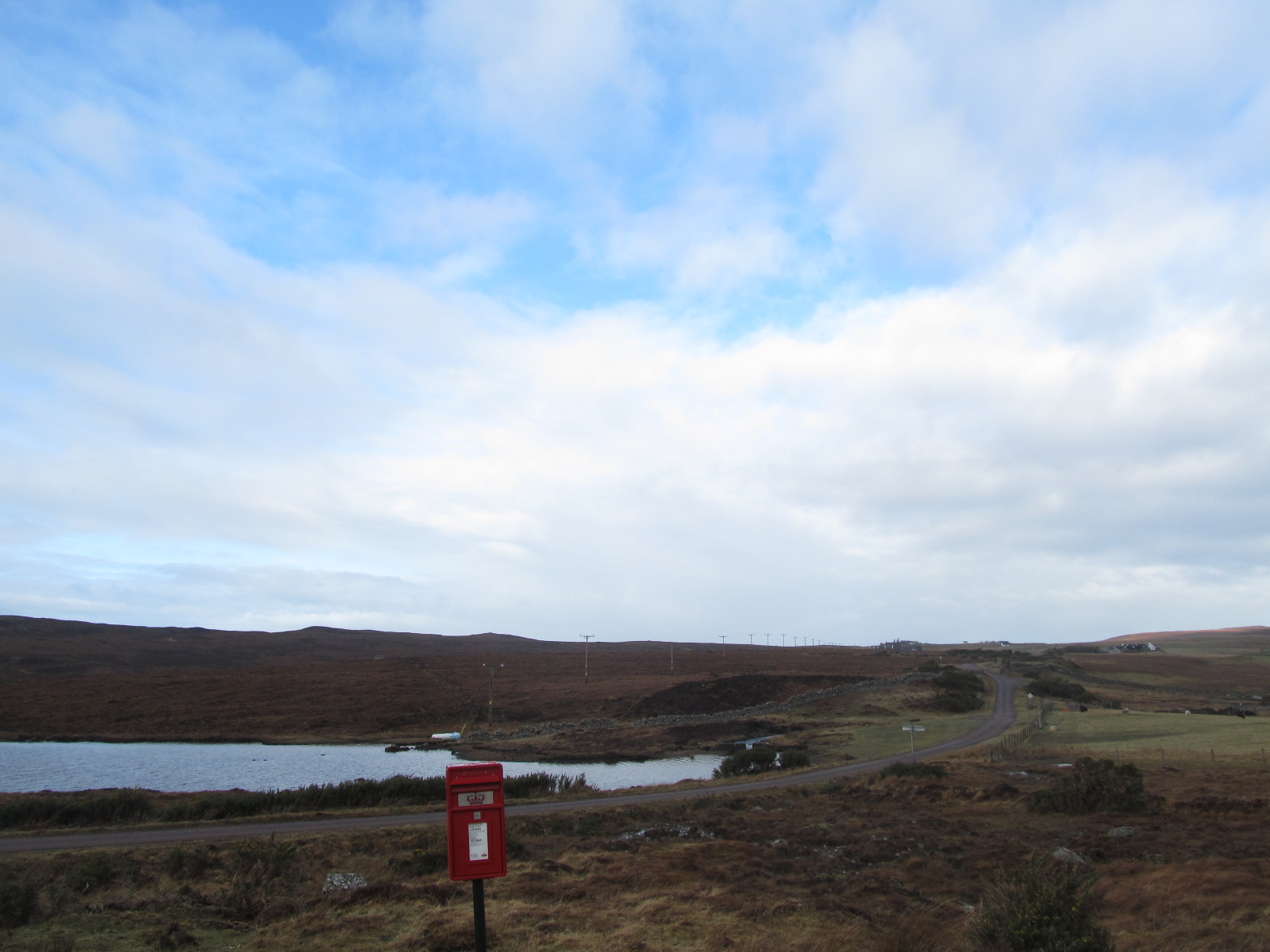
– north northwest (NNW) (Sequence C), opposite to the crescent Sun, in order to chase the Moon’s shadow in the Earth’s atmosphere (Pic.18,19),


Another part of my documentation was to compare the eclipsed sunlight with the car bulbs (Sequence D). I was founded, that during the 90% partial phase the sunlight is nearly equal to the car headlight. At that moment the Sun was clearly visible yet (Pic. 20).
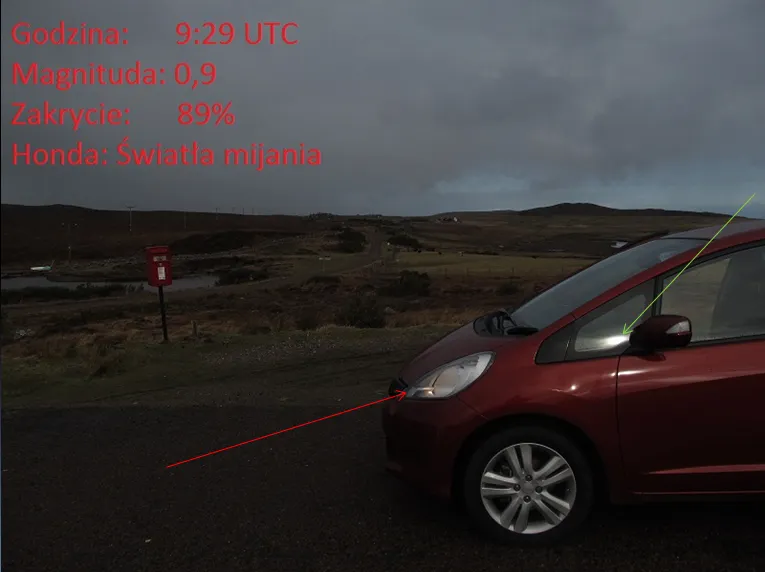
I made photos with EXIF data as follows:
Sun: 1/6000s, ISO 80, F5.6
Sky: 1/125s, ISO 80, F 3.4
Greatest eclipse sky: 1/25s, ISO 80, F 4.5 (some photos only)
Camera: Canon Powershot SX130 IS
To make an overall I bracketed the photos in each section. Let’s describe those sections then:
Sequence A: Contrasting all bracketed photos a big difference may be noticeable with obscuration 63% and higher. Due to increasing cloud coverage, this observation wasn’t continued (Pic.21-24).




Sequence B: View towards the west, from where the eclipse was coming. Darkening is visible from 63% obscuration, like below (Pic. 21-24).

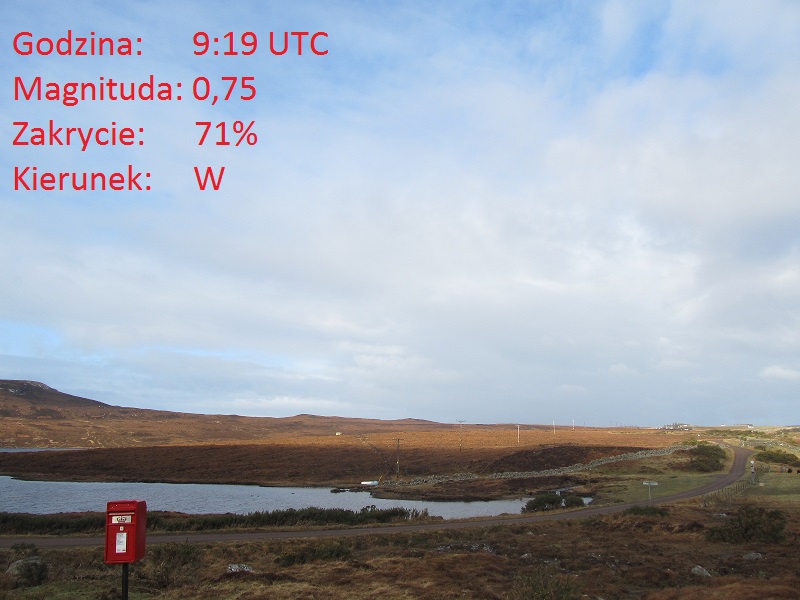
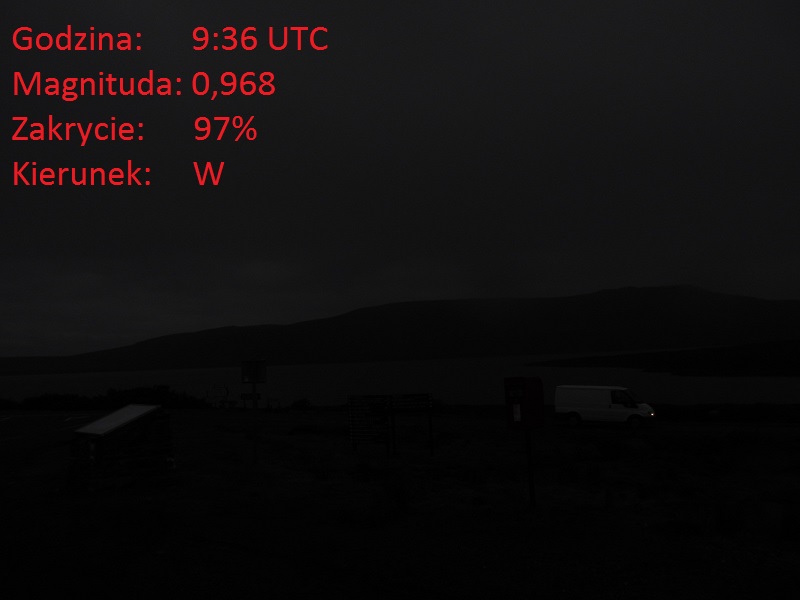
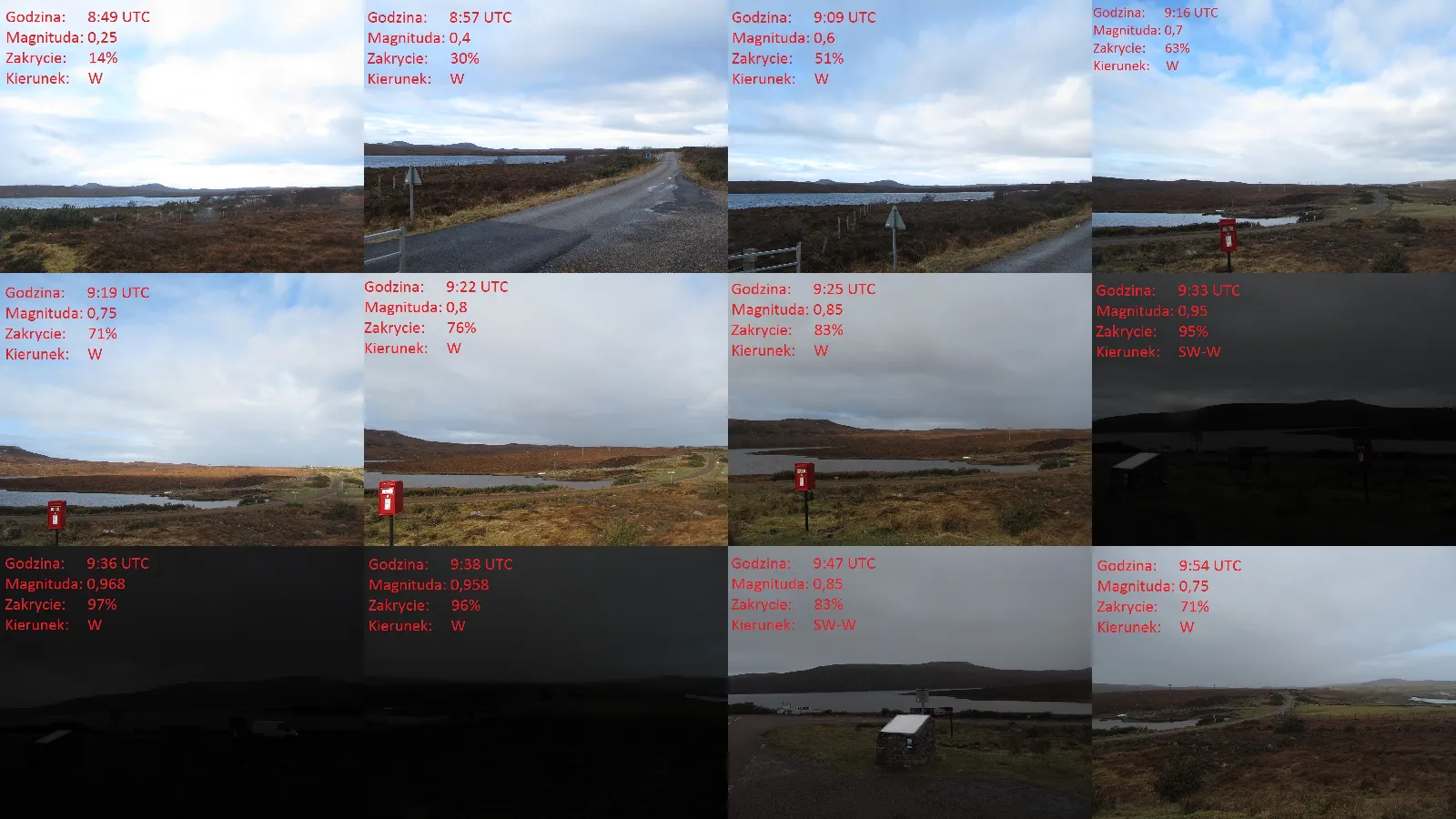
Sequence C: The darkening sky is visible when the Moon clips more than 50% solar disk. When the obscuration is higher than 90%, the sky is much darker and the view changes rapidly (Pic.29-32). According to the picture attached sky is darker on the left side (more above the west horizon). Actually, the Moon’s shadow was there.
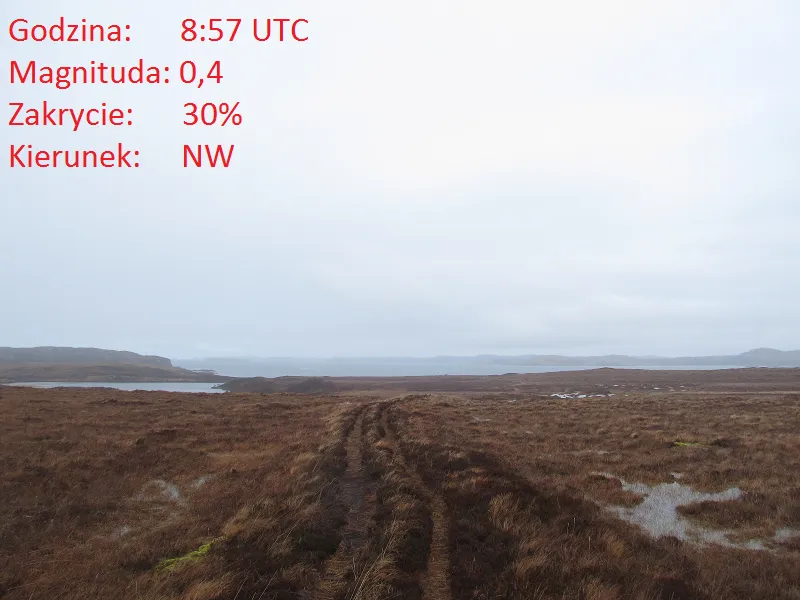


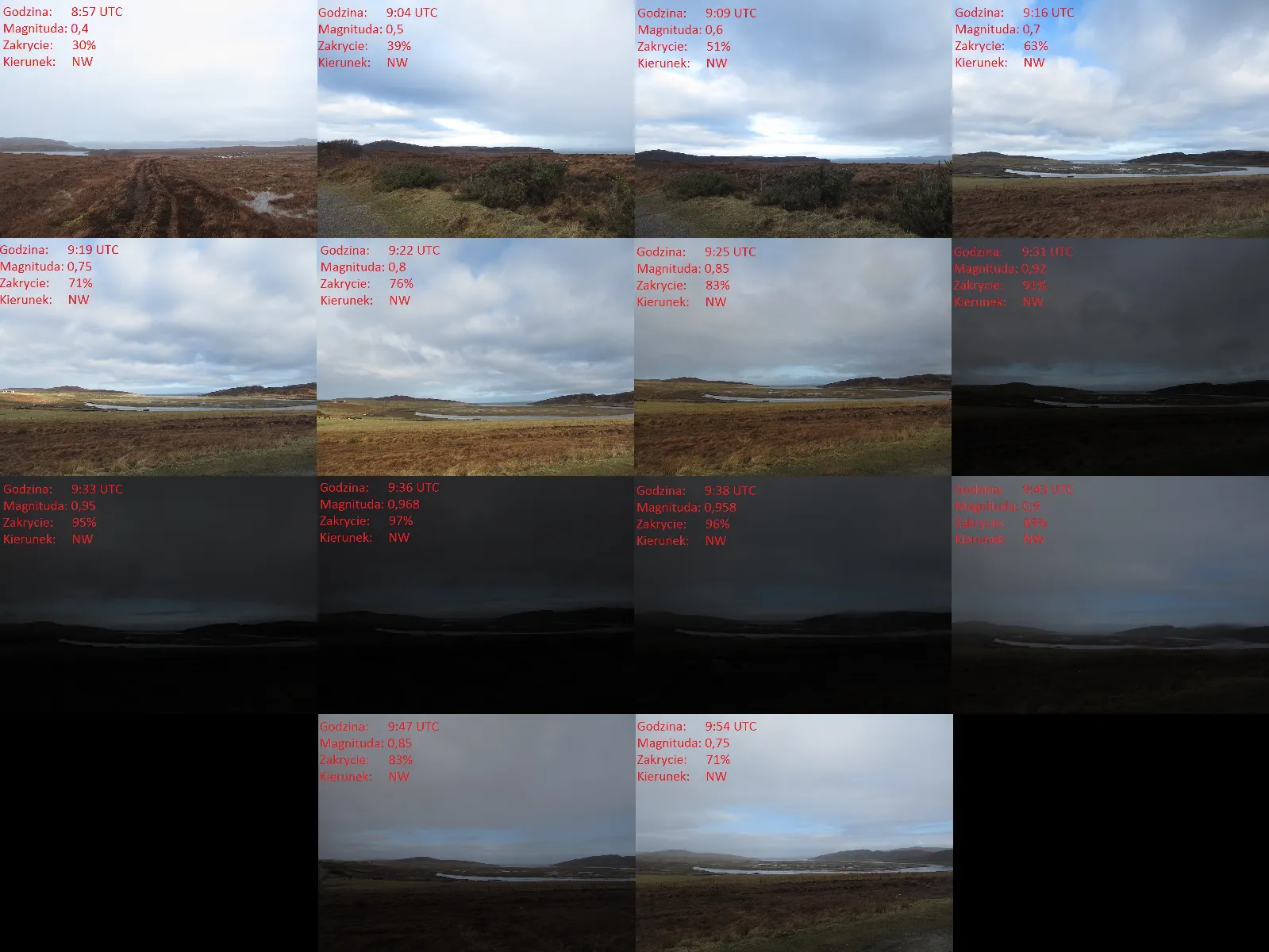
Sequence D: The car’s headlight is equal to sunlight during the obscuration of around 90%. Once the partial eclipse is deeper, the headlights may be stronger than sunlight. This is unfortunately not proved, because of cloud coverage (Pic.33-36).
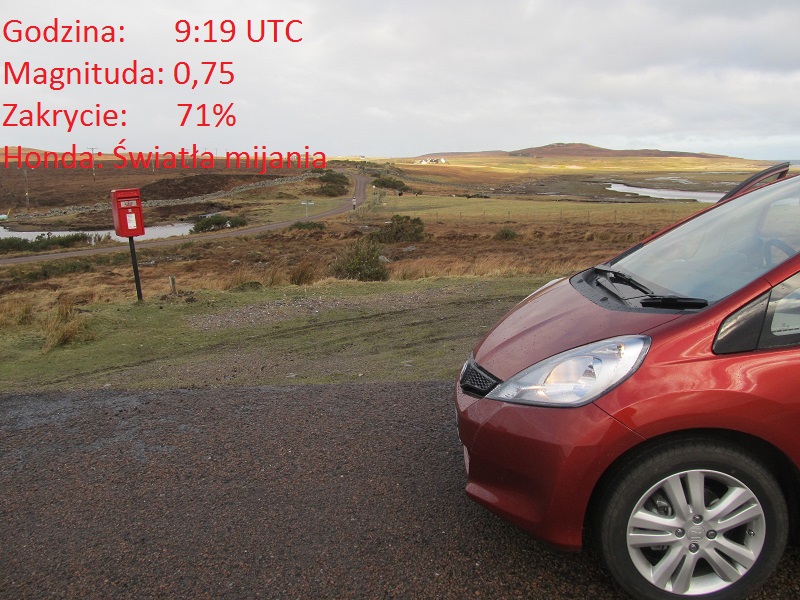
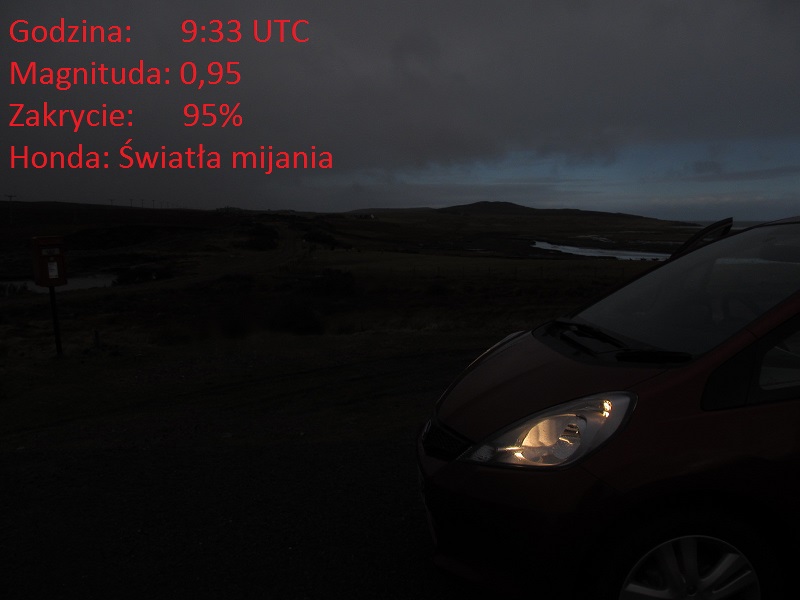


Thanks to the elongated clear gap passing above the northwest horizon I could insightfully analyze the Moon’s shadow movement (Pic. 37-44). As I noticed, the best moment to observe the shadow was just after the greatest eclipse. Then the sky above the northwestern horizon was dark blue. Moreover, you may be able to see the rough border of the shadow in the cropped images (Pic. 43,44).

I was really surprised when I spotted a suddenly darkening sky just above clouds (Pic. 40, green arrow) 7 minutes after the greatest phase (magnitude 0,9, obscuration 89% !).
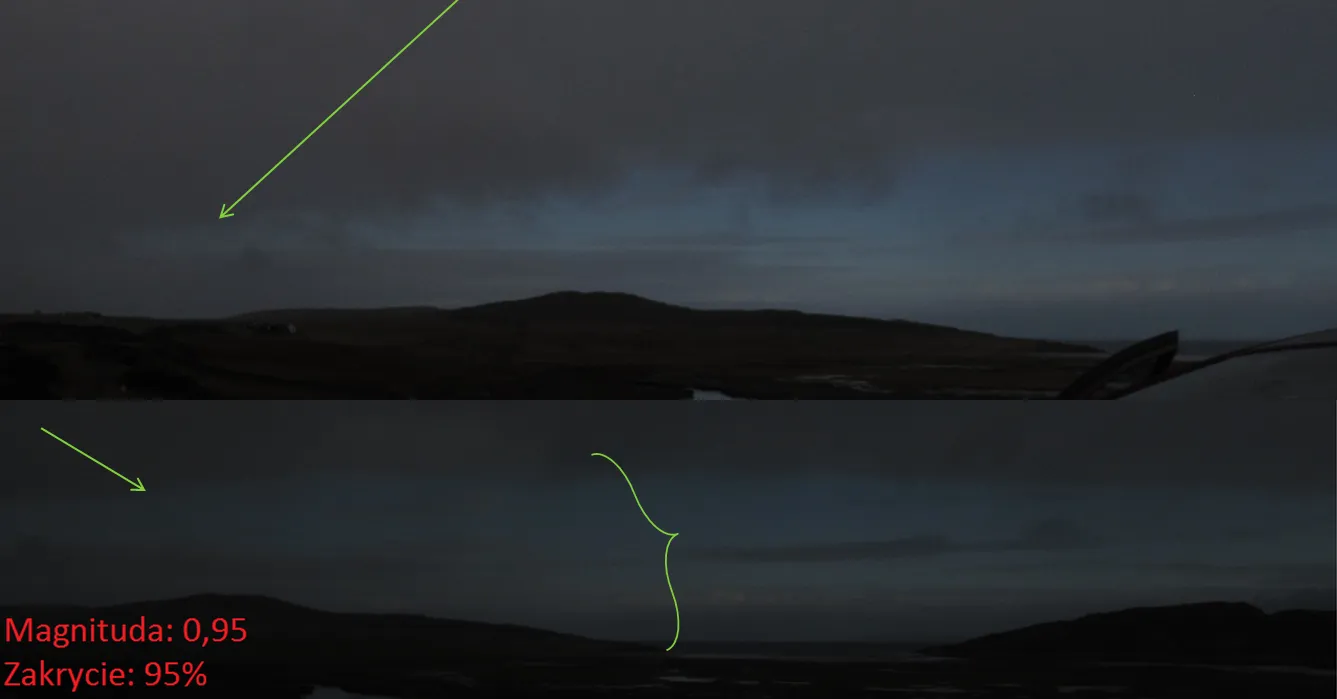


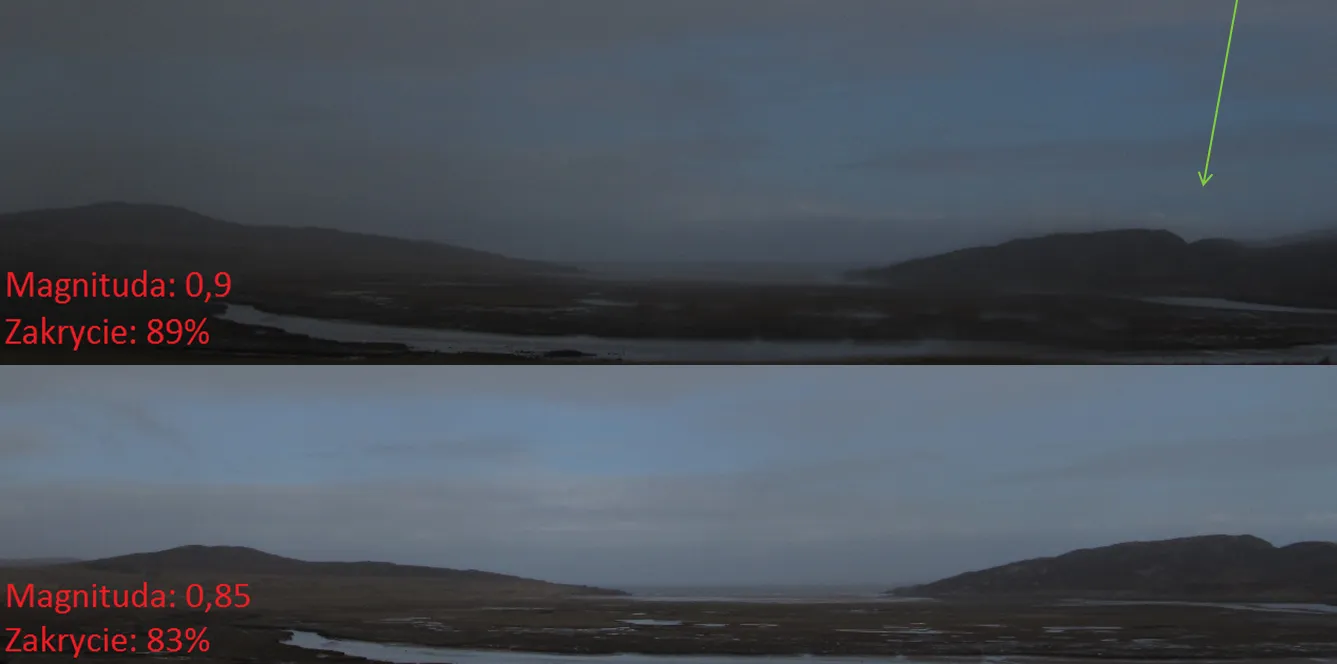
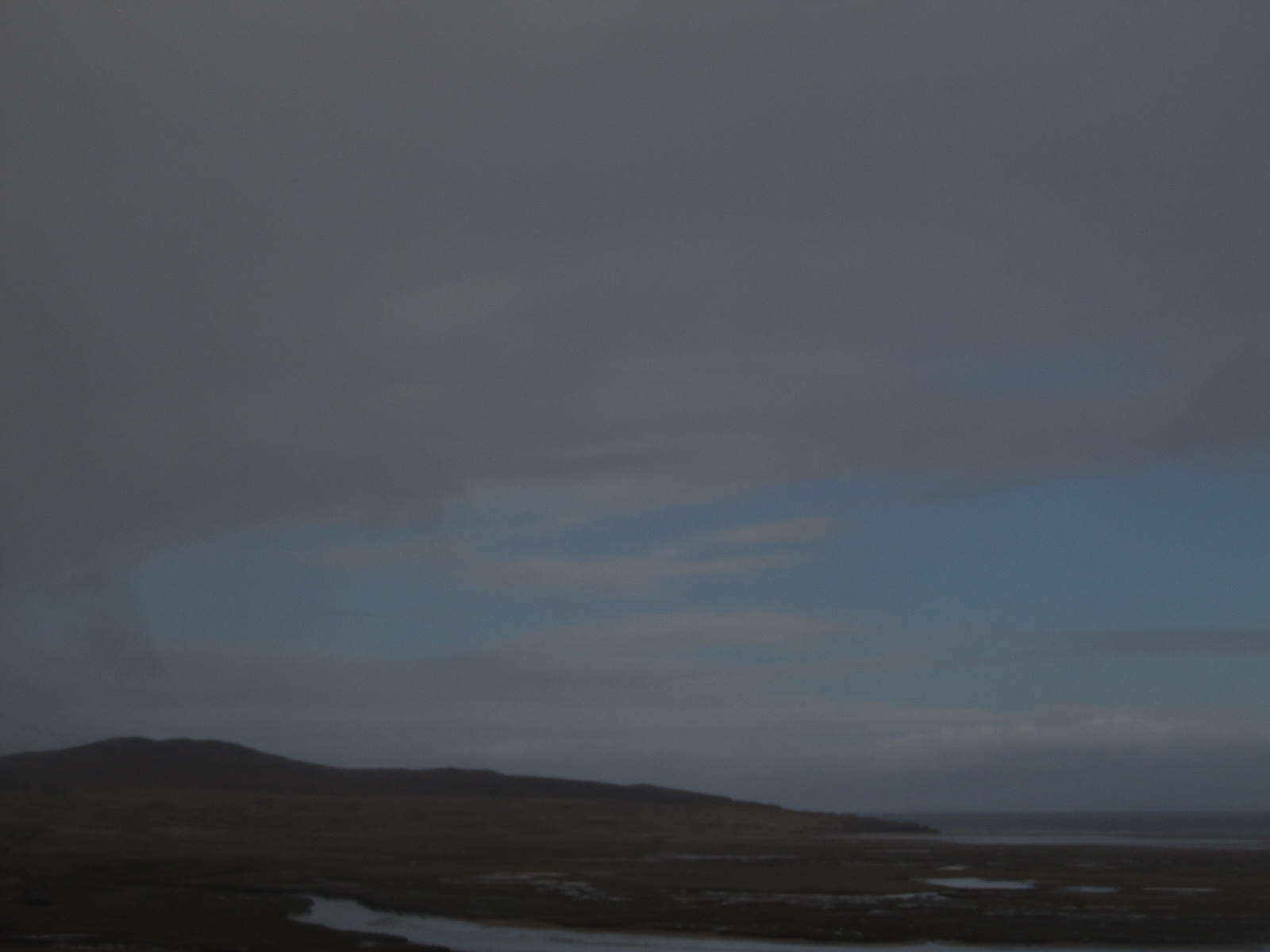



Conclusions:
Before I saw this almost total solar eclipse I was considering some issues. I could prove some of them, by making this observation. All conclusions are listed below:
1) During the partial solar eclipse with obscuration higher than 50% (magnitude 0,59 (we are able to see the darkening of the sky, especially on the opposite side to the Sun.
2) When eclipse obscuration is higher than 50% you may see the difference in the sunlight density by the naked eye on your observation site.
3) When obscuration is higher than 75% sky, the scene is darkening faster. We can then say, that we are experiencing a deep partial solar eclipse.
4) During a deep partial solar eclipse with magnitude 0,9 and higher (obscuration 89%) sky becomes dark blue, and the animals may be concerned. The light density is more or less alike during a cloudy day.
5) When the magnitude is 0,95 or higher it may be needed to use dipped headlights in the car and switch indoors. The observer may witness twilight.
The eclipsed Sun
I was able to see the crescent Sun until 9:30 UTC. It was quite easy to capture pictures because the clouds veiled the solar disk and created a natural filter.
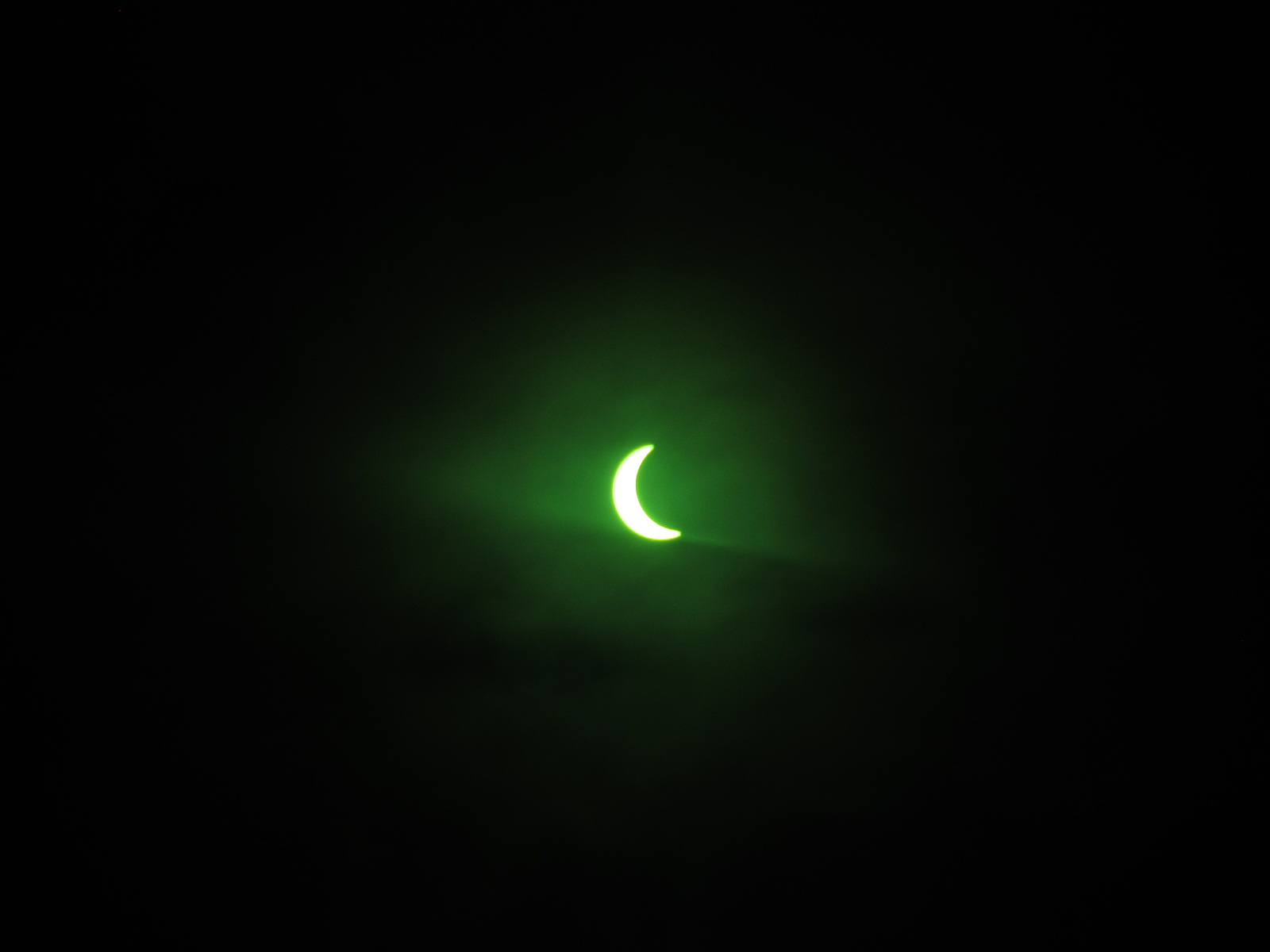




It was an amateur observation only. I hope, that it be continued in the future. Despite the bad weather, this “expedition” was well worth the effort. Unfortunately, I chose the worst option due to the weather. As I saw afterward in every different location called in this article the weather was better. Even across the Faroe Islands, where chances for sunshine are very slim (merely 6% days per year), people could enjoy this remarkable phenomenon. Scotland, unfortunately, was cloudy and rainy with some elongated sunny spells. The weather on the Outer Hebrides, where I was considering going was very similar. I did very well when I set out from Cambridge. There, as one member of the Cambridge Astronomy Association said the Sun was out just before the end of the eclipse. A thick fog covered East Anglia for the entire morning hours. I did also well with renting a car because the weather in Ullapool was much worse. I hope, that the next solar eclipse expedition will be much more successful.
After the eclipse, we back to Ullapool and carried on the trip across northwest Scotland. I will elaborate more on this in the next article.
Mariusz Krukar
References:
- Sytinskaya N.N., Sharonov V.V., 1963, Measures of the brightness and color of the solar corona studied at six eclipses, (in:) The Solar Corona; Proceedings of IAU Symposium no. 16 held at Cloudcroft, New Mexico, U.S.A. 28-30 August, 1961. Edited by John Wainwright Evans. International Astronomical Union. Symposium no. 16, Academic Press, New York, 1963., p.301
Links:
Footages:
- https://www.youtube.com/watch?v=hNM95J8Nb3w – almost total solar eclipse above the Isle of Lewis
- https://www.youtube.com/watch?v=vaKeiXpBlt8 – almost total solar eclipse in Stornoway
- https://www.youtube.com/watch?v=eL3GU2JDMjs – TSE in the Faroe Islands
- https://www.youtube.com/watch?v=dRAkhQ6CfmA – TSE in Svalbard
- https://www.youtube.com/watch?v=PFycHsyyGS0 – deep partial solar eclipse from North Queensferry (Scotland)
- https://www.youtube.com/watch?v=feR12pQ8dXc – Hamferð – Deyðir varðar (live during the solar eclipse in The Faroe Islands, March 20th, 2015)
- https://www.youtube.com/watch?v=QvEpvMK9BTc – TSE 2015 from the plane
- https://www.youtube.com/watch?v=CHapz-kPL5k – almost total solar eclipse in Iceland (part 1)
- https://www.youtube.com/watch?v=nrkwEPA7hLw – almost total solar eclipse in Iceland (part 2)

